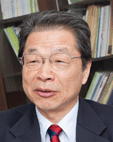DOI: 10.1039/C2CC90049A
(Profile)
Chem. Commun., 2012, 48, 4525-4526
Interview with Yoshinori Yamamoto
| ||||||
Do you remember what it felt like to publish your first ChemComm article?
Yes, my first ChemComm (DOI: 10.1039/C29690001457) was my fifth paper, and reported the novel reaction of ethyl diazoacetate with π-allyl nickel bromide. At that time (1969), I was a PhD student; I wrote this paper by myself without any assistance from my supervisor and submitted to ChemComm. I was very excited that the paper was accepted very quickly. This is the origin of my enthusiasm for carrying out research and publishing papers in chemical journals.How has your research evolved from your first to your most recent article?
My research during my PhD course concerned carbene chemistry, primarily focusing on its reaction mechanism, relation between its electronic state and stereochemical outcome of the addition reaction and structural elucidation of carbene using physical methods. My first to fourth papers were connected with those themes. In the fifth paper (ChemComm), I reported the reaction of the diazo compound (carbene precursor) with the organometallic substrate. This was my first paper, in which organometallic substrates were handled and organic synthetic aspects were emphasized rather than the mechanistic investigation. Since then, my major research subject has been on organic synthesis using organometallic reagents and metallic catalysts. My most recent ChemComm reports aerobic oxidation of alcohols using a nanoporous gold catalyst. Therefore, I believe that my first ChemComm triggered my lifelong passion for research.What do you like most about publishing in ChemComm?
The very quick response of the reviewing process and the short processing time before publication are beneficial for me. Reviewers' opinions are, in general, fair. The journal covers a wide range of cutting-edge chemical research, and therefore I can expect a significant number of readers to see my paper.What aspect of your research are you most excited about the moment?
I am very much excited by nanoporous metal skeleton catalysts, which can be fabricated by dealloying an appropriate metal (M1) from its mother alloy (M1M2M3…), leading to a nanoporous catalyst MetalNPore (M2M3…). This catalyst is robust, easily recoverable from the reaction mixture, can be used repeatedly, and no supporting substrates are needed. Molecular catalysts, including transition metals, and nanoparticle catalysts are well known. I believe that MetalNPore is the third generation green catalyst, and our team is very excited to develop green molecular transformations using MetalNPore. Another exciting subject to me is dye-sensitized solar cells and bulk-heterojunction solar cells and how organic chemists can impact on this green solar process. Our team is also heavily involved in this theme.What is the best part of your job?
I still like to see new reactions, new transformations, and new synthesis using organometallic reagents and catalysts, although now I am heavily involved in the administration of our research institute. Students and younger researchers occasionally discover something new from their experiments, and it is most enjoyable for me to think about the meaning and significance of this small finding, and discuss its future research direction with another team member. Discussion with younger researchers is a good way to keep myself young.What is the secret to success in scientific publishing?
When I was a postdoctoral fellow of the late Prof. H. C. Brown at Purdue University, he told me that one paper should report one finding, it should not contain many things and should not mix up two or more different issues. Then, readers can easily and quickly catch the message from this paper. I have followed his advice for more than 40 years.What is your advice to young emerging scientists?
My experience in academic life is the following: an experimental laboratory is a Golconda (source of great wealth); the ability to continue is a strong power; and life is like integral rather than differential calculus.What do you do in your spare time?
In the evening, I enjoy watching professional baseball and soccer. In the holidays, I visit my sons' homes (or they come to my home) and I enjoy seeing my grandchildren.By the time I'm 100, I would like to have…
...published 1000 papers, but also contributed to the support of younger researchers who have potential in academia.| This journal is © The Royal Society of Chemistry 2012 |

